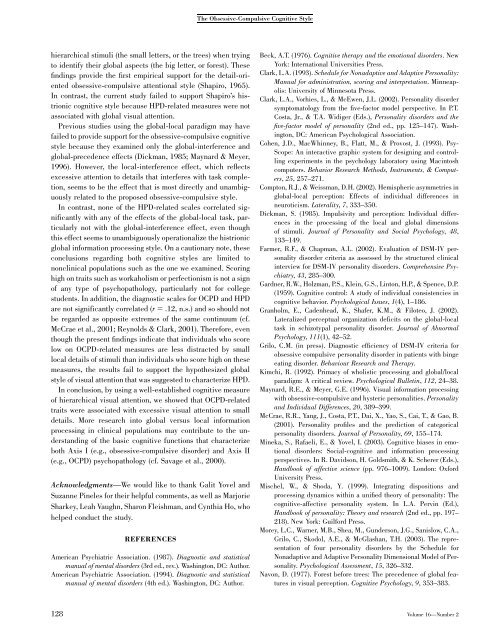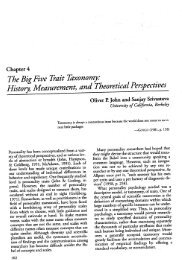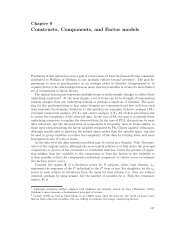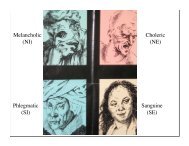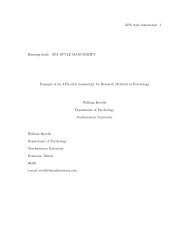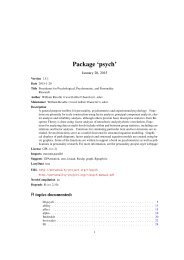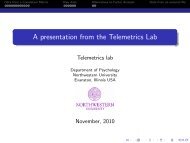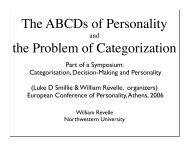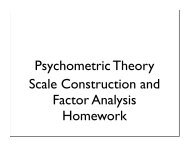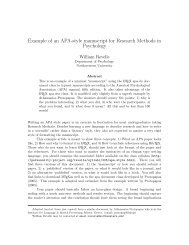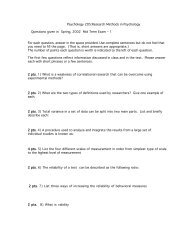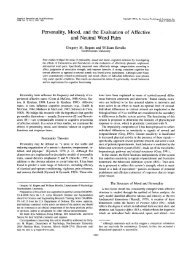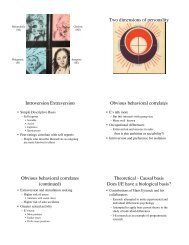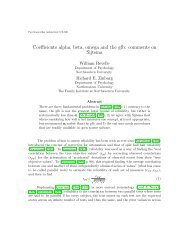Who Sees Trees Before Forest? - The Personality Project
Who Sees Trees Before Forest? - The Personality Project
Who Sees Trees Before Forest? - The Personality Project
Create successful ePaper yourself
Turn your PDF publications into a flip-book with our unique Google optimized e-Paper software.
<strong>The</strong> Obsessive-Compulsive Cognitive Stylehierarchical stimuli (the small letters, or the trees) when tryingto identify their global aspects (the big letter, or forest). <strong>The</strong>sefindings provide the first empirical support for the detail-orientedobsessive-compulsive attentional style (Shapiro, 1965).In contrast, the current study failed to support Shapiro’s histrioniccognitive style because HPD-related measures were notassociated with global visual attention.Previous studies using the global-local paradigm may havefailed to provide support for the obsessive-compulsive cognitivestyle because they examined only the global-interference andglobal-precedence effects (Dickman, 1985; Maynard & Meyer,1996). However, the local-interference effect, which reflectsexcessive attention to details that interferes with task completion,seems to be the effect that is most directly and unambiguouslyrelated to the proposed obsessive-compulsive style.In contrast, none of the HPD-related scales correlated significantlywith any of the effects of the global-local task, particularlynot with the global-interference effect, even thoughthis effect seems to unambiguously operationalize the histrionicglobal information processing style. On a cautionary note, theseconclusions regarding both cognitive styles are limited tononclinical populations such as the one we examined. Scoringhigh on traits such as workaholism or perfectionism is not a signof any type of psychopathology, particularly not for collegestudents. In addition, the diagnostic scales for OCPD and HPDare not significantly correlated (r 5 .12, n.s.) and so should notbe regarded as opposite extremes of the same continuum (cf.McCrae et al., 2001; Reynolds & Clark, 2001). <strong>The</strong>refore, eventhough the present findings indicate that individuals who scorelow on OCPD-related measures are less distracted by smalllocal details of stimuli than individuals who score high on thesemeasures, the results fail to support the hypothesized globalstyle of visual attention that was suggested to characterize HPD.In conclusion, by using a well-established cognitive measureof hierarchical visual attention, we showed that OCPD-relatedtraits were associated with excessive visual attention to smalldetails. More research into global versus local informationprocessing in clinical populations may contribute to the understandingof the basic cognitive functions that characterizeboth Axis I (e.g., obsessive-compulsive disorder) and Axis II(e.g., OCPD) psychopathology (cf. Savage et al., 2000).Acknowledgments—We would like to thank Galit Yovel andSuzanne Pineles for their helpful comments, as well as MarjorieSharkey, Leah Vaughn, Sharon Fleishman, and Cynthia Ho, whohelped conduct the study.REFERENCESAmerican Psychiatric Association. (1987). Diagnostic and statisticalmanual of mental disorders (3rd ed., rev.). Washington, DC: Author.American Psychiatric Association. (1994). Diagnostic and statisticalmanual of mental disorders (4th ed.). Washington, DC: Author.Beck, A.T. (1976). Cognitive therapy and the emotional disorders. NewYork: International Universities Press.Clark, L.A. (1993). Schedule for Nonadaptive and Adaptive <strong>Personality</strong>:Manual for administration, scoring and interpretation. Minneapolis:University of Minnesota Press.Clark, L.A., Vorhies, L., & McEwen, J.L. (2002). <strong>Personality</strong> disordersymptomatology from the five-factor model perspective. In P.T.Costa, Jr., & T.A. Widiger (Eds.), <strong>Personality</strong> disorders and thefive-factor model of personality (2nd ed., pp. 125–147). Washington,DC: American Psychological Association.Cohen, J.D., MacWhinney, B., Flatt, M., & Provost, J. (1993). Psy-Scope: An interactive graphic system for designing and controllingexperiments in the psychology laboratory using Macintoshcomputers. Behavior Research Methods, Instruments, & Computers,25, 257–271.Compton, R.J., & Weissman, D.H. (2002). Hemispheric asymmetries inglobal-local perception: Effects of individual differences inneuroticism. Laterality, 7, 333–350.Dickman, S. (1985). Impulsivity and perception: Individual differencesin the processing of the local and global dimensionsof stimuli. Journal of <strong>Personality</strong> and Social Psychology, 48,133–149.Farmer, R.F., & Chapman, A.L. (2002). Evaluation of DSM-IV personalitydisorder criteria as assessed by the structured clinicalinterview for DSM-IV personality disorders. Comprehensive Psychiatry,43, 285–300.Gardner, R.W., Holzman, P.S., Klein, G.S., Linton, H.P., & Spence, D.P.(1959). Cognitive control: A study of individual consistencies incognitive behavior. Psychological Issues, 1(4), 1–186.Granholm, E., Cadenhead, K., Shafer, K.M., & Filoteo, J. (2002).Lateralized perceptual organization deficits on the global-localtask in schizotypal personality disorder. Journal of AbnormalPsychology, 111(1), 42–52.Grilo, C.M. (in press). Diagnostic efficiency of DSM-IV criteria forobsessive compulsive personality disorder in patients with bingeeating disorder. Behaviour Research and <strong>The</strong>rapy.Kimchi, R. (1992). Primacy of wholistic processing and global/localparadigm: A critical review. Psychological Bulletin, 112, 24–38.Maynard, R.E., & Meyer, G.E. (1996). Visual information processingwith obsessive-compulsive and hysteric personalities. <strong>Personality</strong>and Individual Differences, 20, 389–399.McCrae, R.R., Yang, J., Costa, P.T., Dai, X., Yao, S., Cai, T., & Gao, B.(2001). <strong>Personality</strong> profiles and the prediction of categoricalpersonality disorders. Journal of <strong>Personality</strong>, 69, 155–174.Mineka, S., Rafaeli, E., & Yovel, I. (2003). Cognitive biases in emotionaldisorders: Social-cognitive and information processingperspectives. In R. Davidson, H. Goldsmith, & K. Scherer (Eds.),Handbook of affective science (pp. 976–1009). London: OxfordUniversity Press.Mischel, W., & Shoda, Y. (1999). Integrating dispositions andprocessing dynamics within a unified theory of personality: <strong>The</strong>cognitive-affective personality system. In L.A. Pervin (Ed.),Handbook of personality: <strong>The</strong>ory and research (2nd ed., pp. 197–218). New York: Guilford Press.Morey, L.C., Warner, M.B., Shea, M., Gunderson, J.G., Sanislow, C.A.,Grilo, C., Skodol, A.E., & McGlashan, T.H. (2003). <strong>The</strong> representationof four personality disorders by the Schedule forNonadaptive and Adaptive <strong>Personality</strong> Dimensional Model of <strong>Personality</strong>.Psychological Assessment, 15, 326–332.Navon, D. (1977). <strong>Forest</strong> before trees: <strong>The</strong> precedence of global featuresin visual perception. Cognitive Psychology, 9, 353–383.128 Volume 16—Number 2


